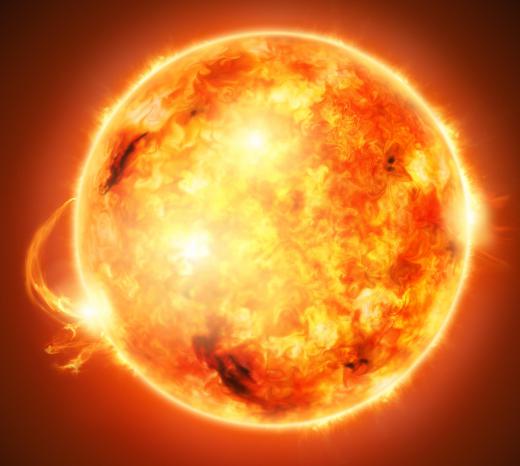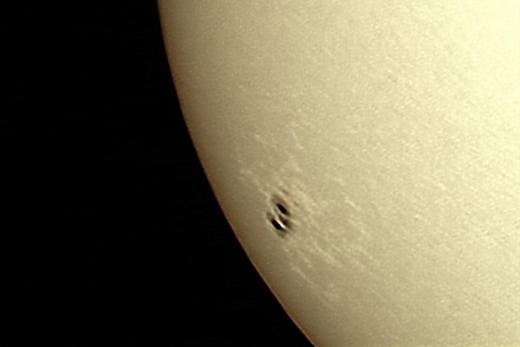What are Sun Bursts?
 Mary McMahon
Mary McMahon
Sun bursts are sudden releases of energy from the sun's atmosphere, known as the corona. Although the bursts are not visible to the naked eye, they represent tremendous amounts of power, and they can have an impact on Earth and more distant planets as the energy travels through the solar system. During periods of increased solar activity, sun bursts can become severe enough to disable satellites and other equipment, as humans have learned to their chagrin.
Changes in the sun's level of activity are caused by the sun's rotation. Like other bodies in space, the sun moves, and as it does, it creates a solar cycle which is caused by rotational forces along the surface of the sun. Sun bursts typically start with sunspots, dark areas which appear on the sun when the cooler inner core of the sun is temporarily exposed by the shifting corona. When sunspots start to spread, it can signal an expected increase in solar activity.

Solar flares, another type of sun burst, occur when the corona releases huge amounts of energy in the fraction of a second, causing a bright spot to appear. Solar flares often occur around sunspots, although they also occur inside the corona, where they cannot be confirmed with visual observations. A big solar flare can release enough energy to interfere with communications on Earth, as the electromagnetic energy from the sun interacts with Earth-bound communications systems and satellites.

In a radical form of sun burst called a coronal mass ejection (CME), the sun pushes out huge flares of plasma. These plasma flares can push against the Earth's atmosphere, causing especially bright, prolonged, and brilliant auroras, and they also increase radiation levels in space substantially. CMEs are one of the reasons that space travel is potentially very dangerous, as the increased radiation level could pose a risk to living organisms in spacecraft.

Scientists can use the ebb and flow of sun bursts to track the sun's cycles, and to gather more information about how the sun works. The activities observed in the sun are also known to occur in other stars, even though researchers cannot usually see them in action because of the great distances involved. Understanding patterns of sun bursts is important to the business community as well as the scientific community, because sun bursts can interrupt satellite launches, the flight of spacecraft, and many other human activities, sometimes with devastating effects.
AS FEATURED ON:
AS FEATURED ON:













Discussion Comments
Why does NASA track sun spots? Can sun spots and sun bursts cause damage to people if they are exposed to them? I have heard that the sun has been more active in the past few years (maybe decade). Does anyone know if this has an effect on the increase in cases of skin cancer? If it does, then it would make sense whenever people say to use more sunscreen because the sun is hotter.
@anon47883- That is an interesting question. I thought about it a little, and I think that maybe a mars mission would be planned when mars was closest to earth. If this were the case, then earth would be between mars and the sun. The earth would then in effect protect anything traveling toward mars from sun flares and coronal mass ejections.
The only thing that might negate the effect of the earth blocking a coronal mass ejection would be if the flare circled around the earth and caught up with the mission. If a mars mission had to be planned around sun flares and the proximity of the planets to each other, It would likely leave a very small window of opportunity for such a mission. I wonder if operational considerations like these had any plan with scrapping a manned mission to mars. It is a lot cheaper and safer to fly robots to mars than people are.
So a Mars mission would be scheduled around sun burst activity?
Post your comments